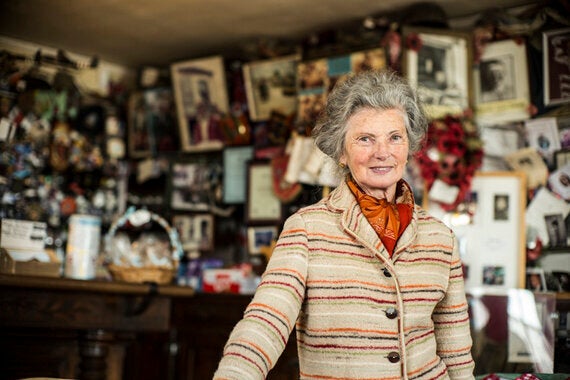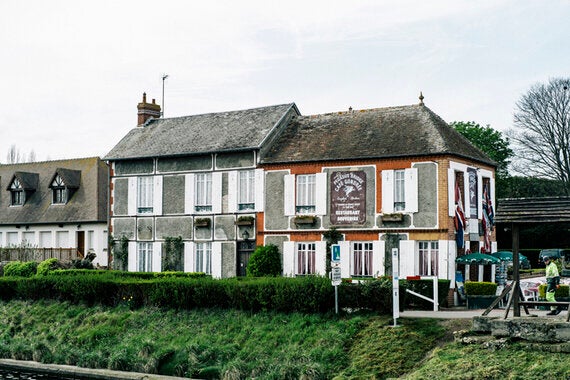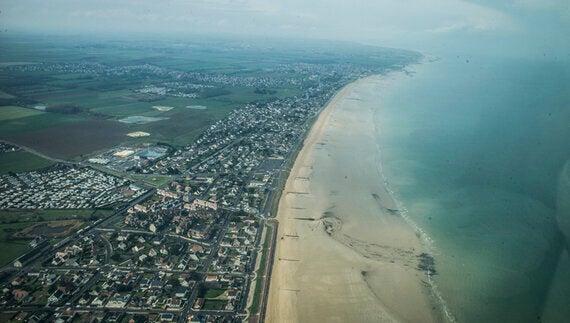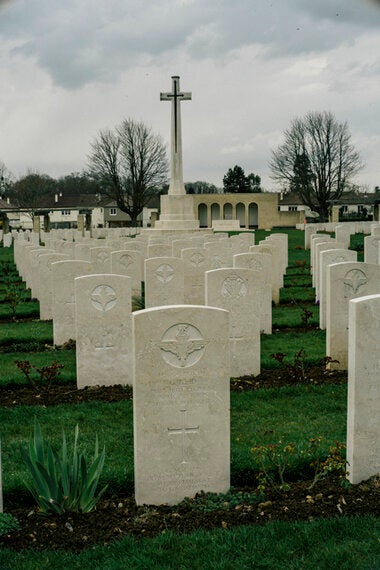
Sitting in Cafe Gondrée cutting into a delicious peach tartlet seeped in Calvados, the events of the final stages of the Second World War become embedded in my mind. It is here in this very cafe, where the start of the preparations for D Day took place.
Arlette Gondrée, a beautiful woman, strikingly dressed in a knitted jacket with a faultless neck-chief, the epitome of Normandy style, stands proudly, having provided us with a delicious home cooked lunch, full of traditional flavours from the region, I slowly gather my thoughts examining the abundance of memorabilia in this sanctuary. Madame Gondrée now joins in the conversation with Colonel Mike Bradley with a further explanation of why this cafe and the Gondrée family are a vital part of the D Day liberation.
Arlette's mother, Thérèsa came from Alsace and could understand German, but acting typically French, the Germans had no idea that she was listening to their every word and at any chance possible was relaying this information to the allied forces.
"The German officers would frequent my parent's cafe here. It was and still is my home. There would be three or four of them at a time all speaking of their plans" she explains in her perfect English, "not only plans for the war, but general conversation, I think this was very significant too."
The German army had planned that if anyone were to attack the bridge it would be blown up, and dynamite was prepared for this - only afterwards did the allied forces learn that the explosives had not yet been placed under the bridge but was in fact awaiting instruction to do so.
"You see this attack by the allied forces" Arlette continues, "had taken the Germans almost completely by surprise, a plan of two years in the making nearly didn't happen in the early of hours of June 6th 1944."
Relevant vital information from the cafe along with a gap in the weather, forced the invasion to go ahead two weeks earlier than previously planned.
For me, a 44 year old who until recently, had taken a slightest interest in our country's past wars (from reading a book such as 'Agent Zig Zag' and watching Foyle's War on television), this meeting with Arlette had made such an impression on me I began to realise that the liberation was not only part of our history, but was in fact Arlette's current life.
She was four when the Allied forces came to liberate her family and to this day has the most enigmatic living shrine - her cafe, complete with ephemera: collectors' items such as posters and photos along with books and cards for sale, books that allow the ignorant mind to investigate the surface and for the educated to delve deeper into the minds and strategies that infiltrated the second world war.

My education continues, with Colonel Mike Bradley and Arlette explaining the events of the night: Major Hans Schmidt had no worries that evening: his troupes were either sleeping or 'whoring' in Bénouville. There was as usual, the tremendous amount of air activity with British and American bombers crossing the channel, he paid no attention and neither did Von Luck, the other officer in charge of the bridge. Luck thought that the low flying planes were dropping by parachute, items for the resistance, the usual episodes. Little did both of these officers know that three gliders were being positioned to land right in front of the north side of the bridge, the next hour following 00.13 (22.13 UK time) was to change one of the most relevant consequences of the Second World War.
Arlette used to hold a larger collection of items handed to her by soldiers and veterans to preserve for the future however, this is now across the road at the Air Forces Museum along with tanks and planes. Also the original single track Pegasus Bridge (the contemporary bridge is a two way traffic system still mechanised to allow for large boats to travel through), is in the museum grounds.
Cafe Gondrée is a living shrine and long may it continue to be so, it allowed me to become interested in a vital part of our history that future generations need to be aware of. I for example would not normally visit the Air Forces Museum, mainly because I have, or rather had no real interest in the war, that is until now after visiting the café on Pegasus Bridge.
There is some talk that the museum wants to take the cafe from Arlette, her home for the past 74 years. I urge you all to visit her café, simply to preserve her legacy and allow yourselves to be utterly educated with a matter that concerns us all.
Colonel Mike Bradley, tells me that Arlette to this very day ensures that the war veterans can eat free of charge continuing the legacy that her mother introduced during those vital hours during the taking of Pegasus Bridge on D Day, where her family cafe was used as a make shift hospital.
The special cafe is just one of the enormous interests of the day, which you can experience through Conciair, from RAF Westhampnett. The highly knowledgeable Colonel explains which regiment landed along the 50 miles of beach as you fly low over it. Juno, Gold or Sword may be beaches you may have heard in connection with D Day, only when you fly over them can you really understand how many people lost their lives to preserve our freedom: I salute the 156,000 soldiers who landed on the Normandy beaches to fight for us. The 6483 ships included 287 mine sweepers, 1213 war ships, 7 battle ships, 3 aircraft carriers, 100 destroyers and 4000 landing craft.

I flew with Conciair from RAF Westhampnet to the airfield at Carpiquet, Caen, Normandy. The day trip starts from £545 for the trip to this special café on Pegasus Bridge and a cemetery (other bespoke packages available). One film I have yet to see is 'Band of Brothers', where now I think I will have a new understanding of the longest day.
After my day trip to see Arlette and the Bridge that helped the allied forces break through into the German stronghold on June 6th 1944, my interest in current warfare has suddenly taken a turn. I appreciate why Madame Gondrée is a living legend

Photos by Lara Platman